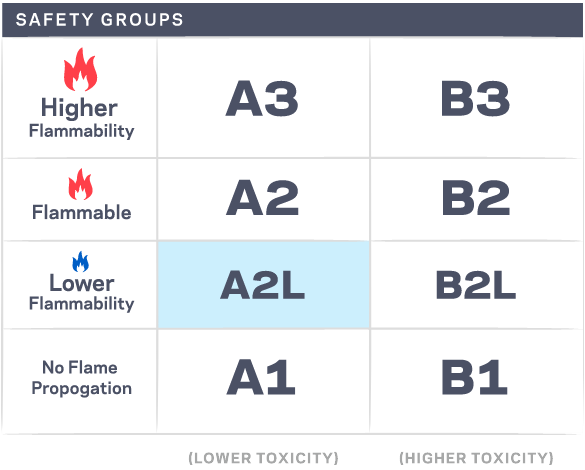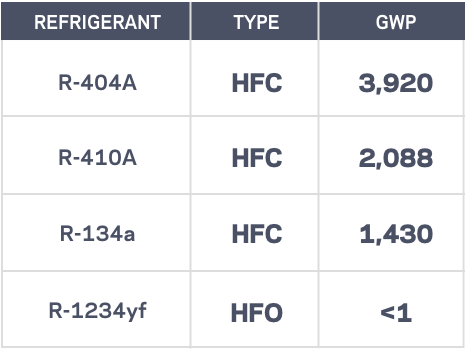Understanding A2L Refrigerants
SAFE, SUSTAINABLE, AND COST-EFFECTIVE SOLUTIONS FOR HVACR APPLICATIONSAn In-Depth Guide to Understanding A2L Refrigerants

You Must Accept YouTube Cookies and Refresh Browser to Play This Video
Open video on YouTubeWhat are A2L refrigerants?
Named for their ASHRAE safety classification, A2L refrigerants are characterized by mild flammability, low toxicity, and low global warming potential (GWP). They include hydrofluoroolefins (HFOs) and HFO blends. A2L refrigerants offer similar operating characteristics to legacy refrigerants, a safer profile than ammonia and hydrocarbon refrigerants, and are more energy efficient than R-410A and transcritical CO₂ systems.
As the world confronts the challenge of climate change, A2Ls have emerged as a replacement for older, high-impact refrigerants like HFCs and HCFCs in air conditioning and commercial refrigeration systems. A2Ls are essential for helping businesses meet the global objectives outlined in the Montreal Protocol and the Kigali Amendment, regional regulations like the U.S. AIM Act and Canada’s ODSHAR, as well as for achieving the objectives of the EU Green Deal.
A2L refrigerants, or A2Ls, are used in refrigeration systems around the world, making sure that cold items stay cold.
But did you know that using A2Ls can save you money and help protect our planet?
Here’s how. A2Ls with low global warming potential can increase system efficiency, lowering emissions through reduced energy consumption.
They also have very low flammability, making them safer to use in a broad range of applications.
And that’s not all. Since A2Ls can make your system more efficient, your operating cost will be lower throughout the lifecycle of your refrigeration equipment.
With Opteon A2L refrigerants, you can do the smart thing for your business and the planet.
Opteon. The performance today demands.The future tomorrow deserves.
Reach out to an Opteon™ expert to learn which A2L refrigerants are now available in your area, and which are right for your application.
-
What are HFOs?
HFOs (short for hydrofluoroolefins) are a family of refrigerants that were developed to replace older solutions like HCFCs and HFCs. HFOs have a much lower global warming potential (GWP) than legacy refrigerants and zero ozone depletion potential (ODP). Visit this page for details on HFOs.
-
How safe are A2Ls?
Though mildly flammable, A2Ls are safe when handled properly. Like all refrigerants, specific codes and standards apply. Learn more about safe handling of A2L refrigerants.

-
Where are A2L refrigerants currently available?
A2L refrigerants are widely available in Europe and Japan, and their adoption in North and South America is accelerating. Many U.S. states have amended their building codes to allow the use of A2Ls, and broad adoption of these refrigerants is expected by 2024 as codes and standards are finalized.
-
What is driving the adoption of A2Ls?
As regulating bodies worldwide continue the push for more stringent emissions controls, A2L solutions—namely HFOs and HFO blends—are playing a crucial role in helping the world transition away from legacy refrigerants. The HFO refrigerant R-1234yf, for example, offers a 99% reduction in GWP compared to R-134a.
HFO refrigerants also have many advantages over industrial gases (aka “naturals”) including ammonia, CO₂, and propane. The benefits of HFOs include lower total cost of ownership, lower lifecycle emissions, wider product availability, and in some cases, a much-improved safety profile.
-
What is the importance of GWP?
Global warming potential (GWP) is a measure of how much potential energy the emissions of one ton of a particular gas will absorb over a given period, relative to the emissions of one ton of carbon dioxide (CO₂).
The word “potential” is used because GWP only becomes a factor if a leak occurs. (Refrigerants are not meant for release into the environment.)

It is important to note that GWP is just one factor influencing refrigerant sustainability.
For instance, energy efficiency is a vital factor when choosing between low GWP solutions. Trials have shown that refrigeration systems using the HFO refrigerants R-454C and R-454A produce 10-year total emissions of up to 25% lower than a transcritical CO₂ (R-744) booster system and up to 15% lower than a propane (R-290)/glycol system.
Despite the continued promotion of industrial gases (aka “natural” refrigerants) as sustainable solutions, A2L refrigerants offer lower total cost of ownership, reduced lifecycle emissions, better safety profiles, and broader product availability than alternatives like CO₂, ammonia, and hydrocarbons.
GLOBAL REFRIGERANT REGULATORY LANDSCAPE
CFC and HCFC regulations are structured according to a phaseout schedule that leads to the discontinuation of production and importation in a specific time frame.
HFC regulations are based on a phasedown schedule that considers the GWP-weighted volume (defined as CO₂-equivalent tons) of an entire class of products during a specified set of baseline years, and then reduces the available CO₂-equivalent tons over time in order to drive the industry to lower GWP solutions. By the final years of the HFC phasedown, countries will reach 15–20% of their original baseline and remain at that level going forward. Each country can decide on the most effective mechanism to reduce the GWP of products being used; for example, CO₂-equivalent quota allocations, specific GWP limits by application, tighter leak management, maintenance requirements, or a combination of the above.
Click on your country of interest to view the regulation time horizon.
Do these regulations apply to you?
The likely answer is “yes.” If you are a refrigeration/air conditioning equipment manufacturer, auto maker, industry supplier, contractor, facilities operator, or business owner using any type of refrigeration, air conditioning, or heat pump technology, the changing global regulations will likely impact you and your business.
High GWP HFC refrigerants are being phased down in favor of low GWP alternatives. Have you started planning for the transition? If you need help, contact our experts.
The Optimal Balance
Opteon™ refrigerants feature zero ozone depletion potential and lower GWP values under AR4/AR5 than the HFCs they are designed to replace. Specifically, Opteon™ XL refrigerants have an ASHRAE and ISO Safety classification of A2L and deliver very low GWP solutions (for instance, Opteon™ XL10 has a GWP of <1 per the IPCC Fifth Assessment Report).
Compared to other lower GWP alternatives, Opteon™ refrigerants offer improved:

Success Stories
Opteon™ XL refrigerants are proving their value in installations around the world.





